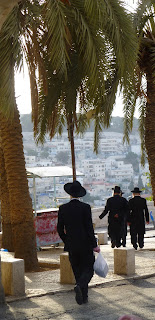So what is this stuff that defines us? Some of it is the everyday stuff of living and those things tell a story of who we are. Our things are intricately interwoven with our identity. I went to my car the other day and chuckled at what one can tell about me from the clutter within. In my 2005 Prius I have two yoga mats and reusable bags from Trader Joes and Whole Foods. There are frequently programs from theater events and nonprofit boards on which I serve. The detritus of my everyday life tells you something about me without me even being present.
The category of stuff that I find most challenging is that of papers and books. I come from a family that is inordinately fond of information. An old friend used to joke that if you plotted information density there would be a huge vibrating black dot over my parents' home. For years my father videotaped everything that interested him as if the act of videotaping acquired all of the knowledge contained within. I am afraid that I am also guilty. Information gives me comfort even if I absorb it only by osmosis.
I have books that I know full well I will never pick up again, but they represent my history of reading. While electronic reading and a list now satisfy my sense of ownership, there is still that history reflected in very tangible books from my past. And then there are the books that populate my shelves that I never read and think I might someday, I remember one time I picked up a Jack Finney book from my shelves and was captivated by time travel. Now I contemplate what other treasures might be lurking. Kind of like shopping your closet.
I once asked a friend how she kept her home so tidy, cleansed of that paper that finds its way to the level surfaces of my home. She motioned to a cluster of woven baskets which she filled up with papers before guests arrived. Upon my return, I went out to Bed, Bath and Beyond and purchased several large baskets which worked perfectly until they were full. I had forgotten to ask her about the next step. How do you empty them? Or do you? Perhaps you just buy more.
Over time I cobbled together an approach. Periodically I go through them and throw out information on events that have passed, but there is a perma layer which always remains. So what is in that layer? A Jewish children's book that I got in the mail. I don't have kids and my step-daughters' kids aren't Jewish. So why do I hold onto this? Well first of all, it's a book, but does it perhaps reflect some sense of the road not taken? I have articles on places I've visited and places I'd like to. Ironically two are about a place my husband and I are planning to visit soon, but I made the reservations totally unaware that I had these articles. There is a sketch of Tai Chi poses an old friend recorded for me almost 20 years ago. Every time I pull them from the perma layer, I think, "Perhaps some day I'll try them" and with that thought, back they go. These scraps seem to represent an identity as well, often the one not assumed, but that coyly beckons.
I was listening to MPR recently and heard a show from This American Life on Andy Warhol's time capsules, 610 boxes of detritus that he began to assemble when moving to a new studio. Someone suggested that he box his stuff and call it art and he went with it. Three women are charged with cataloging his stuff and have a sense of knowing him from his belongings. They talk about which relationships he was happiest in and which of his partners they prefer. From such ephemeral items as a note from Bianca Jagger signed with a lipstick kiss to dirty underwear, they catalog it all. I totally understand the impulse behind such a project though doubt I'll have the luxury of catalogers. Perhaps I should just buy more baskets.











